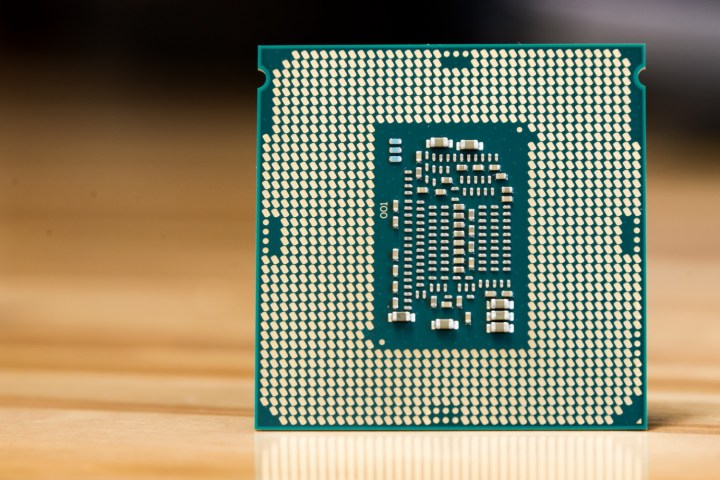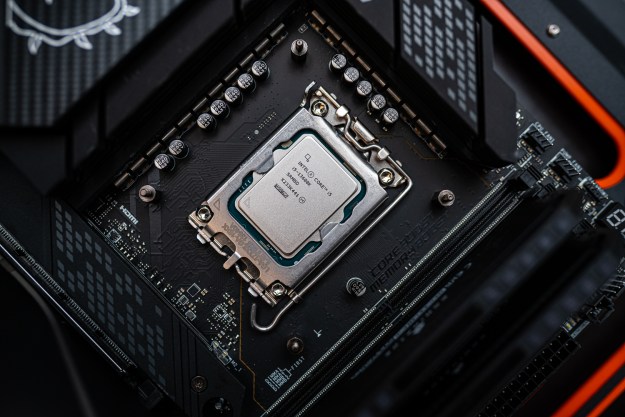
Intel is slated to release eight new eighth-generation “Coffee Lake” desktop processors in the near future, according to listings spotted on SiSoftware’s Sandra Platinum platform. They join the six desktop-bound chips released toward the end of 2017 and inject five Pentium- and Celeron-branded chips into the new Coffee Lake generation. Intel’s initial Coffee Lake launch consisted of four “U” processors targeting high-performance laptops.
Here are the upcoming processors:
| Model | Cores / Threads |
Base Speed |
L3 Cache |
Price |
| Core i5-8600 |
6 / 6 |
3.1GHz |
9MB |
$329 |
| Core i5-8500 |
6 / 6 |
3.0GHz |
9MB |
$290 |
| Core i3-8300 |
4 / 4 |
3.7GHz |
8MB |
$211 |
| Pentium G5600 |
2 / 4 |
3.9GHz |
4MB |
$142 |
| Pentium G5500 |
2 / 4 |
3.8GHz |
4MB |
$127 |
| Pentium G5400 |
2 / 4 |
3.7GHz |
4MB |
$97 |
| Celeron G4920 |
2 / 2 |
3.2GHz |
2MB |
$80 |
| Celeron G4900 |
2 / 2 |
3.1GHz |
2MB |
$64 |
Notice that the list includes the Core i5-8600. Intel already offers the Core i5-8600K, but the newer K-free model doesn’t support overclocked speeds. The “K” suffix means the chip is unlocked, allowing end-users to manually increase the base and boost speeds beyond their out-of-the-box settings. Other suffixes you see throughout Intel’s branding include H (high-performance graphics), U (ultra-low power), and T (power optimized).
The big deal with Intel’s eighth-generation rollout was that the company introduced a six-core chip to the mainstream market. The company continues with another pair of Core i5 processors with six cores along with a Core i3 chip with only four cores. The remaining five in Intel’s third wave are only dual-core products although the Pentium models provide four threads, which translates to two processing lines per core.
Keep in mind that these eight chips are not “official” products, so the information could change, or is simply invalid. The maximum turbo clock speeds for the Core i5 processors are unknown at this point while the Core i3, Pentium, and Celeron chips won’t have boost speeds. All models fit on motherboards with the LGA 1151 socket (seat), and Intel’s Z370 chipset although we expect the company to introduce new chipsets complementing the new budget-friendly CPUs.
Here is a better look at the new Core i5 and Core i3 chips mixed in with the current batch:
| Model | Cores / Threads |
Base Speed |
Boost Speed |
L3 cache |
| Core i5-8600K |
6 / 6 |
3.6GHz |
4.3GHz |
9MB |
| Core i5-8600 |
6 / 6 |
3.1GHz |
TBD |
9MB |
| Core i5-8500 |
6 / 6 |
3.0GHz |
TBD |
9MB |
| Core i5-8400 |
6 / 6 |
2.8GHz |
4.0GHz |
9MB |
| Core i3-8350K |
4 / 4 |
4.0GHz |
N/A |
8MB |
| Core i3-8300 |
4 / 4 |
3.7GHz |
N/A |
8MB |
| Core i3-8100 |
4 / 4 |
3/6GHz |
N/A |
6MB |
What is surprising is that Intel’s third Coffee Lake wave doesn’t include additional Core i7 products for desktops. Right now, there are only two models: The six-core unlocked Core i7-8700K targeting gamers, and the locked non-K “mainstream” i7-8700 model. The latter version has a slower base speed of 3.2GHz versus the i7-8700K’s 3.7GHz base speed. But there’s only a 100MHz difference between their boost speeds. Right now, the Core i7-8600 and 8500 series appears locked to Intel’s laptop CPU family.
We expect to hear more about the eight new processors in a few weeks, as speculation points to a possible launch around Valentine’s Day. Who needs chocolate, right?
Editors' Recommendations
- Everything we know about Lunar Lake, Intel’s big next-generation chips
- Intel 14th-gen Meteor Lake: architecture, specs, and performance
- Intel Meteor Lake is coming to desktop, but there’s a big catch
- Intel’s Core Ultra CPUs are more Apple, less AMD
- Get ready to pay more for Intel’s next-gen CPUs


